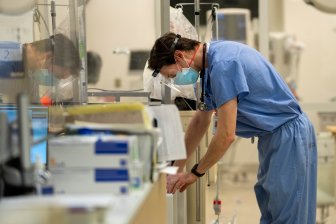A former deputy chief with the Hamilton Paramedic Service is testifying in the trial of two former Hamilton paramedics charged with not doing enough to save Yosif Al-Hasnawi’s life three years ago.

Between Tuesday and Thursday, Hal Klassen has been questioned by the Crown as an expert witness in the trial of Christopher Marchant and Steven Snively, who are both charged with failing to provide the necessaries of life when they responded to the scene where Al-Hasnawi had been shot in 2017.
Crown attorney Linda Shin has been interviewing Klassen, who was a deputy chief for the Hamilton Paramedic Service at the time, about a number of issues related to paramedic training, procedures, equipment, clinical care, and standard protocols.
The testimony has included demonstrations of equipment like the ZOLL X-series defibrillator that would have been in Marchant’s and Snively’s ambulance that night.
Shin also asked Klassen about the use of restraints on a patient and whether paramedics have “discretion” to use physical restraints on a patient.
Klassen said paramedics do not have the authority to take patients against their will and are only permitted to use physical restraints if it’s authorized by police or a physician.
If restraints are used, Klassen said it must be documented in the ambulance call report because it’s an “unusual circumstance.”
“Typically, paramedics aren’t involved with restraining people,” Klassen said. “Most of the time people want to come with us to the hospital. There’s the component of taking away someone’s liberty, or you’re saying, ‘We’re going to take you against your will to a health care facility.’ And so there’s, you know, legal implications to doing that.”
Shin also asked Klassen about the factors that determine which hospital the patient is sent to — including the nature of the patient’s condition, travel time to the hospital, and other underlying issues.
In the case of a “penetrating wound” — like the one in Al-Hasnawi’s abdomen — Klassen said the standard procedure is to have the patient sent to the local trauma hospital, which was Hamilton General Hospital in this particular case.
While it’s ultimately up to the dispatcher to send an ambulance to a particular hospital, the dispatcher bases that decision on what paramedics at the scene identify as the primary concern, or “chief complaint.”
One of the dispatchers who had been working on the night of Al-Hasnawi’s death testified earlier in the trial that she was told by Marchant that the primary concern was getting him EPT — “emergency psychiatric treatment.”
The dispatcher said she had wanted to send Al-Hasnawi to Hamilton General Hospital, but because of the EPT identifier, she was required to send him to St. Joseph’s Hospital, which was further away and much busier that night.
Another issue that came up during questioning was Marchant asking the 911 dispatcher about the priority of the call.
Court previously heard that Marchant had radioed the call centre to ask why it was prioritized at an emergency level if Al-Hasnawi’s injury was “superficial.”
The dispatcher who spoke to Marchant and who testified on the second day of the trial had told the court that she didn’t have time to respond to him, saying the call centre was short-staffed that night, and that dispatchers aren’t usually responsible for explaining the priority of calls to paramedics.
Klassen echoed that sentiment during his testimony on Thursday.
“They could question whether or not they heard the address correctly or a piece of information correctly, but … they shouldn’t be asking questions about the reasoning behind the call or the priority level assigned.”
Shin also asked whether paramedics are trained to determine what kind of gun may have caused a bullet wound and whether the type of weapon would factor into their decision on where to take the patient.
“Any difference set out in the training or the policy manual with respect to gun calls — that there’s a distinction to be made between a pellet gun, a small-caliber handgun, a rifle, at any at all?”
“No,” Klassen said.
When Shin asked why that’s the case, Klassen said, “There’s no way of knowing what kind of damage is being done internally by any kind of a projectile.”
Further questioning on Thursday highlighted how paramedics are trained to assess penetrating wounds on the abdomen, with Shin questioning what level of training paramedics have in identifying internal bleeding caused by a penetrating wound.
Klassen said it would be “difficult” to assess how much internal bleeding may have been caused by the wound. He pointed out that it’s impossible to see “what’s beyond the skin.”
On Friday, it’s expected that Klassen will remain in the witness box for cross-examination from Jeff Manishen and Michael DelGobbo, defence counsel for Marchant and Snively.
The trial is expected to continue up until Dec. 24 and will resume in January.




Comments